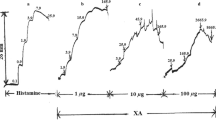Abstract
A tricyclic chromone, proxicromil (sodium 6,7,8,9-tetrahydro-5-hydroxy-4-oxo-10-propyl-naphtho (2,3-b) pyran-2-carboxylate), has been tested for activity against certain immunological and inflammatory reactions.
When given parenterally it suppressed the development of delayed hypersensitivity reactions in sensitized mice and guinea-pigs but did not affect the rejection of skin allografts in mice. The compound had no activity against certain in vitro correlates of delayed hypersensitivity reactions (lymphocyte transformation and lymphokine activity), but did have an inhibitory effect on lymphokine (MIF) production at 10−4 M but not at 10−5 M.
Proxicromil was also found to be active in non-immunologically mediated models of inflammation and in models having an immunological component which are known to be sensitive to non-steroidal anti-inflammatory drugs (adjuvant arthritis, reversed passive Arthus reaction).
The activity of this compound was enhanced when administered in arachis oil when compared to its activity in saline.
Proxicromil has no direct activity on the development of immune responsiveness but appears to suppress the expression of delayed hypersensitivity and immune complex mediated hypersensitivity reactions by virtue of its anti-inflammatory properties. This activity is not associated with inhibition of cyclo-oxygenase.
Similar content being viewed by others
References
J. Augstein, H. Cairns, T.B. Lee, J. Suschitzky, R.E.C. Altounyan, D.M. Jackson, J. Mann, T.S.C. Orr andP. Sheard,A New Orally Effective Chromone Derivative for the Treatment of Asthma, Agents and Actions,7, 443 (1977).
R.R.A. Coombs andP.G.H. Gell,Classification of Allergic Reactions Responsible for Clinical Hypersensitivity and Disease, in:Clinical Aspects of Immunology, 3rd Edition (Eds. P.G.H. Gell, R.R.A. Coombs and P.J. Lachman; Blackwell, 1973).
G.L. Asherson andW. Ptak,Contact Delayed Hypersensitivity in the Mouse. I. Active sensitisation and Passive Transfer, Immunology15, 405 (1968).
M. Baba, T. Harada andS. Morikawa,Studies on Delayed Hypersensitivity in Mice. I. Physicochemical and Biological Properties of Preferential Antigens for Inducing Delayed Hypersensitivity in Mice, Acta path. jap.27, 185 (1977).
D.W. Bailey andB. Usama,A Rapid Method of Grafting Skin on Tails of Mice, Transplant. Bull.7, 424 (1960).
G. Tonelli, L. Thibault andI. Ringler,A Bioassay for the Concomitant Assessment of the Antiphlogistic and Thymolytic Activities of Topically Applied Corticoids, Endocrinology77, 625 (1965).
C.A. Winter, E.A. Risley andG.W. Nuss,Carrageenin Induced Oedema in the Hind Paw of the Rat as an Assay for Anti-Inflammatory Drugs, Proc. Soc. exp. Biol. Med.111, 54 (1962).
B.B. Newbould,Chemotherapy of Arthritis Induced in Rats by Mycobacterial Adjuvant, Br. J. Pharmac.21, 127 (1963).
A. Blackham, H. Radziwonik andI.H. Shaw,The Arthus Reaction in Guinea-pig Knee Joints. A test for Anti-Inflammatory Drugs, Agents and Actions5, 579, (1975).
L. Hudson andF. Hay,Practical Immunology, (Blackwell, 1976), pp. 134–135.
A. Boyum,Separation of Leucocytes from Blood and Bone Marrow, Scand. J. clin. Lab. Invest.21, Suppl. 97, 1 (1968).
E. Pick andP. Kotkes,A Simple Method for the Production of Migration Inhibitory Factor by Concanavalin A Stimulated Lymphocytes, J. Immun. Meth.14, 141 (1977).
R.E. Micallef andF.F. Fenech,FPL 57787 A — New Oral Chromogen in the Treatment of Bronchial Asthma, Allergologia et Immunopathologia5, 519 (1977).
J.P. Girard andT.J. Sullivan,The Effect of Proxicromil, a New Oral Chromone Derivative, in Antigen Challenge Tests in Asthmatic Patients, Clin. Allergy,10, 271 (1980).
N.C. Thompson, A.G.H. Green andJ.W. Kett,Effect of FPL 57787 in Exercise Induced Asthma, Clin. Allergy10, 43 (1980).
T. Yoshida andS. Cohen,Lymphokine Activity in vivo in Relation to Circulating Monocyte Levels and Delayed Skin Reactions, J. Immun.112, 1540 (1974).
A. Postlehwaite, A.S. Thownes andA.H. Kang,Characterisation of Macrophage Inhibitory Factor Activity Produced in vivo by a Cell Mediated Immune Reaction in the Guinea Pig. J. Immun.117, 1651 (1976).
R. Lindquist,Mechanisms of Transplantation Immunity inMechanisms of Immunopathology (Eds. S. Cohen, P. Ward and R. McLusky; Wiley, New York, 1979), pp. 323–353.
J.F. Bach,The Mode of Action of Immunosuppressive Agents (North Holland, 1975), pp. 3–4.
D.A. Long andA.J.P. Martin,Factor in Arachis Oil Depressing Sensitivity to Tuberculin in BCG Infected Guinea-pigs. Lancet1, 464 (1956).
G.W. Outram, A.G. Dickinson andH. Fraser,Slow Encephalopathies, Inflammatory Responses and Arachis Oil, Lancet1, 198 (1975).
P.W. Askenase,Basophil Arrival and Function in Tissue Hypersensitivity Reactions, J. Allergy Clin. Immun.64, 79 (1979).
J. Morley, T.J. Williams, A.J. Slater, D. Cubitt andD.C. Dumonde,Simultaneous Measurement of Accumulation of Isotope Labelled Protein and Erythrocytes in Skin Reactions of Allergic Inflammation in the Guinea-pig, Immunology23, 1113 (1972).
W. Paul, J.L. Beets, M.A. Bray andJ. Morley,Anti-Inflammatory Drug Actions on Allergic Responses in Guinea-pig skin, Agents and Actions8, 509 (1978).
M. Di Rosa, J.M. Papadimitriu andD.A. Willoughby,Histopathological and Pharmacological Analysis of the Mode of Action of Non-Steroidal Anti-Inflammatory Drugs, J. Path.105, 239 (1971).
M. Di Rosa, L. Sorrentino, L.I. Parenti,Non-Steroidal Anti-Inflammatory Drugs, J. Pharm. Pharmac.24, 575 (1972).
S.C.R. Meacock andE. Ann Kitchen,Some Effects of Non-Steroidal Anti-Inflammatory Drugs on Leucocyte Migration, Agents and Actions6, 320 (1976).
Author information
Authors and Affiliations
Rights and permissions
About this article
Cite this article
Keogh, R.W., Bundick, R.V., Cunnington, P.G. et al. The activity of an anti-allergic compound, proxicromil, on models of immunity and inflammation. Agents and Actions 11, 361–372 (1981). https://doi.org/10.1007/BF01982472
Received:
Issue Date:
DOI: https://doi.org/10.1007/BF01982472




